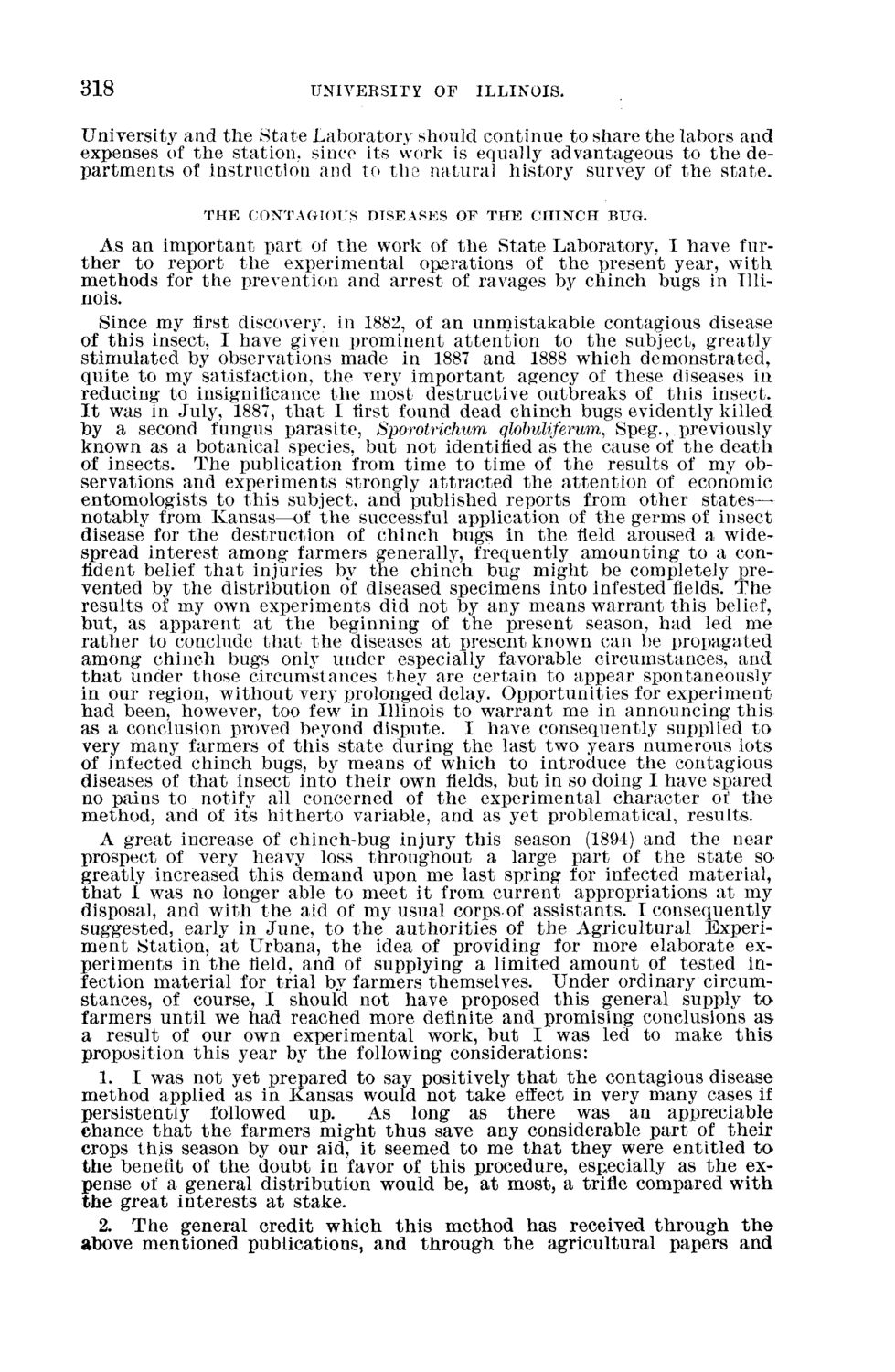| |
| |
Caption: Board of Trustees Minutes - 1894
This is a reduced-resolution page image for fast online browsing.

EXTRACTED TEXT FROM PAGE:
318 UNIVERSITY OF ILLINOIS. University and the State Laboratory should continue to share the labors and expenses of the station, since its work is equally advantageous to the departments of instruction and to the natural history survey of the state. T H E CONTAGK)US DISEASP^S OF T H E CHINCH BUG. As an important part of the work of the State Laboratory, I have further to report the experimental operations of the present year, with methods for the prevention and arrest of ravages by chinch bugs in Illinois. Since my first discovery, in 1882, of an unmistakable contagious disease of this insect, I have given prominent attention to the subject, greatly stimulated by observations made in 1887 and 1888 which demonstrated, quite to my satisfaction, the very important agency of these diseases in reducing to insignificance t h e most destructive outbreaks of this insect. I t was in July, 1887, t h a t I first found dead chinch bugs evidently killed by a second fungus parasite, Sporotrichum qlobuliferum, Speg., previously known as a botanical species, but not identified as the cause of the death of insects. The publication from time to time of the results of my observations and experiments strongly attracted the attention of economic entomologists to this subject, and published reports from other states— notably from Kansas—of t h e successful application of the germs of insect disease for the destruction of chinch bugs in the field aroused a widespread interest among farmers generally, frequently amounting to a confident belief t h a t injuries by the chinch bug might be completely prevented by the distribution of diseased specimens into infested fields. The results of my own experiments did not by any means warrant this belief, but, as apparent at the beginning of the present season, had led me rather to conclude t h a t the diseases at present known can be propagated among chinch bugs only under especially favorable circumstances, and t h a t under those circumstances they are certain to appear spontaneously in our region, without very prolonged delay. Opportunities for experiment had been, however, too few in Illinois to warrant me in announcing this as a conclusion proved beyond dispute. I have consequently supplied to very many farmers of this state during the last two years numerous lots of infected chinch bugs, by means of which to introduce the contagious diseases of t h a t insect into their own fields, but in so doing I have spared no pains to notify all concerned of the experimental character of t h e method, and of its hitherto variable, and as yet problematical, results. A great increase of chinch-bug injury this season (1894) and the near prospect of very heavy loss throughout a large part of t h e state sogreatly increased this demand upon me last spring for infected material, t h a t I was no longer able to meet it from current appropriations at my disposal, and with t h e aid of my usual corps of assistants. I consequently suggested, early in June, to t h e authorities of the Agricultural Experiment Station, at Urbana, the idea of providing for more elaborate experiments in the field, and of supplying a limited amount of tested infection material for trial by farmers themselves. Under ordinary circumstances, of course, I should not have proposed this general supply t o farmers until we had reached more definite and promising conclusions asa result of our own experimental work, but I was led to make t h i s proposition this year by the following considerations: 1. I was not yet prepared to say positively t h a t the contagious disease method applied as in Kansas would not take effect in very many cases if persistently followed up. As long as there was an appreciable chance t h a t t h e farmers might thus save any considerable part of their crops this season by our aid, it seemed to me t h a t they were entitled t o the benefit of the doubt in favor of this procedure, especially as t h e expense of a general distribution would be, at most, a trifle compared with the great interests at stake. 2. The general credit which this method has received through t h e above mentioned publications, and through t h e agricultural papers and
| |